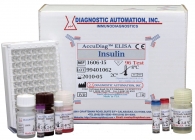
ELISA Kits
- • Anemia ELISA kits
- • Allergy ELISA kits
- • Autoimmune Disease kits
- • Bone Metabolism ELISA kits
- • Blood bank ELISA kits
- • Cancer ELISA kits
- • Cardiac Markers ELISA kits
- • Diabetes Assays ELISA kits
- • Drug test ELISA kits
- • Fertility ELISA kits
- • Food ELISA kits
- • Infectious Disease ELISA kits
- • Other ELISA Kits
- • Parasitology ELISA kits
- • Steroid ELISA kits
- • Thyroid ELISA kits
Rapid Tests
- • Allergy Rapid tests
- • Bone Metabolism
- • Cancer Rapid tests
- • Cardiac markers Rapid tests
- • Drug Tests
- • Fertility Rapid tests
- • Hepatitis Panel
- • Infectious Disease & other tests
- • Other
- • Ovulation Rapid tests
- • Pregnancy tests
- • Urine Reagent Strips tests
IFA Kits
Chemiluminescence Immuno Assays
- • Allergy Assays
- • Autoimmune Thyroid Assays
- • Cardio-Vascular Monitoring
- • Diabetes Assays
- • Fertility Assays
- • Growth Deficiency
- • Infectious Disease Assays
- • Others
- • Steroid Assays
- • Thyroid Assays
- • Tumor Marker Assays
Serology Tests
- • ASO (Anti-Streptolysin-O)
- • CRP (C-Reactive Protein)
- • Mono (Infectious Mononucleosis)
- • RF (Rheumatoid Factor)
- • RPR (Rapid Plasma Reagin)
- • SLE (Systemic Lupus Erythematosus)
Instrumentation



Insulin ELISA kit
| Name |
Insulin ELISA Test |
|---|---|
| Full name |
Human Insulin ELISA Test Kit |
| Category Name | Diabetes Assays ELISA kits |
| Test | 96 |
| Method | ELISA method: Enzyme Linked Immunosorbent Assay |
| Principle | Sandwich Complex |
| Detection Range | 0-300 ulU/ml |
| Sample | 50ul |
| Specificity | 100% |
| Sensitivity | 0.182 ulU/ml |
| Total Time | ~135 min |
| Shelf Life | 12 Months from the manufacturing date |
 |
 |
 |
Insulin ELISA kit description:
The Diagnostic Automation Insulin elisa kit is a quantitative solid phase enzyme-linked immunosorbant assay (ELISA) for in vitro measurement of insulin in human serum and plasma.
Materials provided with Insulin elisa test kit:
A. Insulin Calibrators: Six vials of references for Insulin antigen at levels of
0(A), 5 (B), 25(C), 50(D), 100(E) and 300(F)
B. Insulin Enzyme Reagent: containing enzyme labeled affinity purified monoclonal mouse x-insulin IgG, biotinylated monoclonal mouse x-insulin IgG in buffer
C. Streptavidin Coated Plate: 96-well microplate coated with
D. Wash Solution Concentrate: containing a surfactant in buffered saline
E. Substrate A: containing tetramethylbenzidine (TMB) in buffer
F. Substrate B: containing hydrogen peroxide (H2O2) in buffer
G. Stop Solution: containing a strong acid (1.0 N HCI)
Materials required, not provided:
1. Freshly distilled or deionized water
2. Dispensing system and/or pipette
3. ELISA kit Microplate washer
4. ELISA kit Microplate Reader with 450nm wavelength
5. Quality Control Materials
Insulin Elisa Test Background Information:
Diabetes affects an estimated 16 million Americans, about one third of them do not even know they have the disease. The disease is marked by deficiencies in the body ability to produce and properly use insulin. The most common forms of diabetes are type 1, in which the body ability to produce insulin is destroyed, and type 2, in which the body is resistant to insulin even though some amount of insulin may be produced. Insulin is the principal hormone responsible for glucose metabolism. Secretion of insulin is mainly controlled by plasma glucose concentration and the hormones have a number of important metabolic actions. Its principal function is to control the uptake and utilization of glucose in peripheral tissues via the glucose transporter. Insulin concentrations are severely reduced in insulin-dependent diabetes (DDM) and some other conditions such as hypopituitarism.
Insulin Elisa Test Principle:
Insulin elisa test is a solid phase ELISA and the essential reagents required for an immunoenzymometric assay include high affinity and specificity antibodies (Ab), (enzyme conjugated and immobilized), with different and distinct epitope recognition, in excess, and native antigen (Ag). In this procedure, the immobilization takes place during the assay at the surface of a microplate well through the interaction of streptavidin coated on the well and exogenously added biotinylated monoclonal insulin antibody.
In addition to hypoglycemia Insulin elisa kit has following applications:
1. To assess the residual cell function, especially in newly diagnosed cases of IDDM
2. As an aid to the discrimination between IDDM and NIDDM
3. The diagnosis of insulinoma.
4. In the investigation of the pathophysiology of diabetes mellitus
For more information about ELISA Kits, Rapid Tests, IFA Kits, CLIA Test Kits, or Serology tests, please see our website home page, or contact our Customer Service Representative at 818-591-3030.
When using expected values from Diagnostic Automation Inc, it is important to keep in mind that establishment of a range of values which can be expected to be found by a given method for a population of normal persons is dependent upon a multiplicity of factors, the specificity of the method, the population tested and the precision of the method in the hands of the analyst. For these reasons each laboratory should depend upon the range of expected values established by DAI only until an in-house range can be determined by the analysts using the method with a population indigenous to the area in which the laboratory is located.
ELISA kits - Rapid tests- Drug tests- Pregnancy test - IFA kits - CLIA assays - Serology tests - Instrumentation
©1992 Diagnostic Automation/Cortez Diagnostics Inc. All rights reserved.








